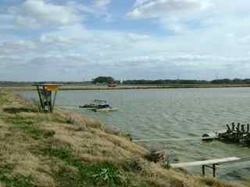
When I interact with aquaculture researchers and farmers, I often hear that they need to add ammonia oxidizing bacteria (AOB) to combat high ammonia in the ponds. Multiple companies appear to offer blends of microbes containing AOB – usually NItrosomonas and Nitrobacter sp. For farmers the questions are:
- Are the currently marketed products effective?
- And, if not – what should I do to control ammonia & nitrite in the ponds?
- Uptake by algae – preferably by eukaryotic (green algae). The algae uses nitrogen to build cells during photosynthesis.
- Use by heterotrophic (carbon waste degrading microbes). Bacteria digest waste materials (even sludge) and use nitrogen (preferably ammonia) in building new cells. This can remove a substantial amount of ammonia.
- Finally, we have ammonia oxidizing bacteria – they require sufficient D.O., pH, and are relatively slow growing. However, they are very efficient at converting ammonia into first nitrite and then nitrate in a two-step process.
So what alternatives do farmers have for ammonia issues? In my experience ammonia can be combatted best through monitoring and good operations. With low water exchange and high stocking densities, I have found that using a heterotrophic microbial addition can help lower ammonia within 2 – 4 days. In addition to improving waste removal and restoring natural balances, the “cleaner” water now supports better eukaryotic algae growth that efficiently remove nitrogen from the water. Unlike cyanobacteria, the eukaryotic algae cause fewer problems with pH swings and off-flavors.
So unless there are special factors and critical ammonia problems, the addition of true AOB microbes is rarely need in aquaculture. I prefer to see farmers add a balanced blend of probiotic and waste degrading microbes that along with beneficial algae form the majority of waste removal biomass in the pond. For best impact of adding heterotrophic microbes, they should be added early on before the pond becomes unbalanced. With small regular doses throughout the season (with higher does as feeding and animal weights increase), the pond will remain in better ecological balance and animals will experience less stress.

 RSS Feed
RSS Feed